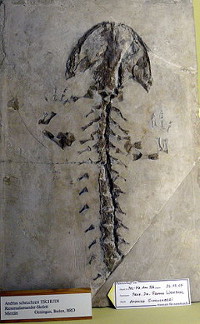
In 1726, the Swiss naturalist Johann Jakob Scheuchzer mistook the skull and vertebral column of a large salamander from the Miocene epoch for the “betrübten Beingerüst eines alten Sünders” (sad bony remains of an old human sinner) and dubbed it Homo diluvii testis, “the man who witnessed the Deluge.” The fossil lacked a tail or hind legs, so he thought it was the remains of a trampled human child:
It is certain that this [rock] contains the half, or nearly so, of the skeleton of a man; that the substance even of the bones, and, what is more, of the flesh and of parts still softer than the flesh, are there incorporated in the stone; in a word it is one of the rarest relics which we have of that accursed race which was buried under the waters. The figure shows us the contour of the frontal bone, the orbits with the openings which give passage to the great nerves of the fifth pair. We see there the remains of the brain, of the sphenoidal bone, of the roots of the nose, a notable fragment of the maxillary bone, and some vestiges of the liver.
The fossil made its way to Teylers Museum in the Netherlands, where in 1811 Georges Cuvier recognized it as a giant salamander. Ironically, Scheuchzer’s original belief is reflected in the fossil’s modern name, Andrias scheuchzeri — Andrias means “image of man.”
